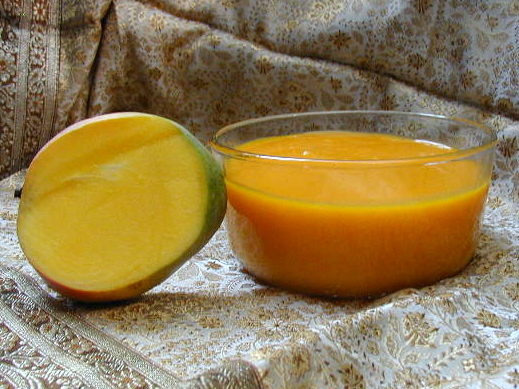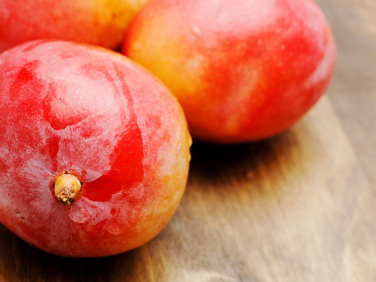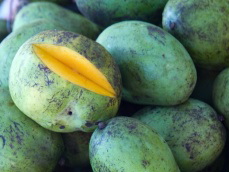
sidebyside, l
(article, Sona Pai)
[%pageBreakSettings maxWords=900] p(blue). Editor's note: This article was included in the 2008 edition of [%amazonProductLink "Best Food Writing" asin=0738212512]. A few months ago, when I heard that the U.S. government had lifted its 18-year ban on importing mangoes from India, I felt a little giddy. I remember eating these mangoes — these amazing mangoes — while visiting my grandparents, aunts, uncles, and cousins in India. These mangoes weren’t like the stringy, pale yellow ones we ate back home in Missouri, the ones that were often sour and so fibrous they made me feel like flossing. These were deep orange inside, buttery soft, and sweet as honey. They’re the mangoes my dad — back when he was a naughty little boy in Gujarat — used to steal from his neighbor’s tree. I’ve visited his old house during each of my four trips to India, and each time I imagine him, skinny and barefoot, scrambling up for a treat. They’re the mangoes my grandfather would haggle for at the bazaar. He’d ignore small talk from the fruit wallah as he scrutinized the rows of fragrant fruit, squeezing this one, smelling that one, accepting a sample, pretending it was no good. [%image feature-image float=left width=400 caption="The king of fruits, now available in the U.S. from India." credit="Photo: iStockphoto/creacart"] When the fruit wallah finally caved (a special price, he said, in honor of my visit from America), my grandfather would select six or seven mangoes, which would last us maybe two days. Back at their airy apartment, my grandfather, grandmother, and I would eat mangoes after every meal, the three of us slurping away in happy silence. Indian mangoes are known as the world’s finest because they have the competitive advantage of being the world’s first. The mango tree, Mangifera indica, originated somewhere between India and Myanmar about 4,000 years ago. Indians have been cultivating them ever since, selecting and propagating the sweetest fruits with the least fiber, and planting more than two million acres of them. Mangoes, a symbol of love, fertility, and good fortune, infuse Indian life and culture. On special occasions, like weddings, New Year’s Day, and Diwali, mango leaves adorn the doorways of Indian homes and temples. The shape of the mango fruit inspired the distinctive Indian pattern, known in the West as paisley, that swoops and swirls across Indian fabrics, artwork, and the henna-inked hands and feet of a bride-to-be. Indians eat mangoes ripe and unripe, raw and cooked, dried and pickled. They blend them with yogurt in a cool glass of mango lassi or serve them sprinkled with a little salt, lime, and chile powder. They simmer them down into mango chutney and preserve them in mustard oil with salt, lime, and spices like cumin, turmeric, fennel, and fenugreek. And they blend them into desserts such as the rich, milky ice cream known as kulfi. Portuguese colonists brought mangoes to Africa and the Americas, where they now grow in the Caribbean, Latin America, Florida, California, and Hawaii. But commercial interests led growers in these parts to breed mangoes with more, not less, fiber; the stringy fiber gives mangoes a more shelf-stable structure and, unfortunately, the texture of a wool sweater. These mangoes are cheaper and easier for Americans to get their hands on, but as anyone who has ever tasted an Indian mango will tell you, there’s no comparison. Period. h3. The sweet, and then the sour India first applied for permission to ship mangoes to the United States in 1989. But rather than choose between two agricultural evils — invasive pests or the high levels of pesticides required to eradicate them — the U.S. government barred the Indian fruits from American shores. Since then, the Indian population in the U.S. has grown from just under 800,000 in 1990 to more than 2.2 million in 2004, and demand for Indian mangoes has increased along with it. As these immigrants settled into their new homes, they got used to the compromises that came with assimilation. They seasoned Rice Krispies, Corn Flakes, and potato chips to replicate the spicy, salty snacks they used to buy for a few rupees on the street. They made sweet-and-sour chutney with apple butter instead of fresh dates and tamarind. They ate mangoes from Mexico with names like Tommy Atkins, Haden, Keitt, and Kent, instead of their beloved Alphonso, Kesar, Dussheri, and Khajri. Some tried to stuff contraband mangoes into their suitcases on return trips from India, and U.S. customs officials grew accustomed to asking gray-haired aunties in saris if they were carrying any mangoes. Most learned to settle for the New World mangoes that Madhur Jaffrey has called “pleasantly hued but lifeless rocks,” because that’s all they could legally get. Until now. [%image sidebyside float=left width=350 credit="Photo courtesy Sona Pai" caption="A bowl of mango pulp from India is a richer color than a fresh New World mango."] When news of the Indian mango’s arrival hit, Indians all over America cheered. In news stories and on blogs, they recalled the mango memories of their youth and argued over which Indian variety was the best. American government officials held ceremonies to mark this significant step in U.S.-India economic relations. They ate mangoes and lauded the “King of Fruits” and “The World’s Best Mangoes.” Forbes magazine reported that, upon tasting an Indian mango for the first time on his 2006 trip to India, George W. Bush turned to Indian Prime Minister Manmohan Singh and said, “This is a hell of a fruit.” The first Indian mangoes arrived in the States in May of this year. As I searched for information about when and where I could get them, I read as much as I could about their impending arrival. Steadily, with each bit of new information I found, the thought of eating Indian mangoes in America became a little less sweet. First, there’s the rub. To get from India to me, these mangoes would of course have to travel thousands of miles. How would that fit into my growing insistence on local produce? Second, there’s the trade-off. Magazines and newspapers widely reported that, in exchange for the mangoes, India would ease its emissions standards to make room for American Harley-Davidson motorcycles on its already choked roads. Do I really want to add to India’s pollution problem just so I can eat some tropical fruit in America? [[block(sidebar). h1. Gimme mangoes The U.S. government’s decision to import Indian mangoes came just as India’s mango season hit full swing this year. Importers scrambled to get them here as soon as possible, and that meant by plane, which is expensive; as a result, this year's shipments have sold out quickly (mostly at Indian groceries) for the premium prices of $35 to $40 a case, or about $3 to $4 per mango. Keep an eye out for them late next spring, in more cities and at better prices. In the meantime, mangoes from Central America, both conventional and organic, are widely available. Look for mangoes that smell like you want them to taste, and that give slightly when you squeeze them. At home, put them in a paper bag for a few days to ripen them. When you've got a nice, ripe mango, this is the best way to eat it: Hold the mango with both hands and, turning it, squeeze gently, until the flesh inside softens into a pulp. (Don't let the skin break under the pressure.) When the mango starts to feel like a water balloon, pop off the little stem nub at the top and begin slurping. When you’ve slurped out all of the juice, pull out the seed and slurp some more. ]] And third, there’s the catch. Still worried about pests — particularly the mango seed weevil, which bores through a mango’s flesh and then matures within its seed — the United States is accepting Indian mangoes on one condition: They must first be irradiated to destroy the weevils, which haven’t yet made their way into North American crops. That means those delicious fruits — the ones that you can spoon like custard and that taste like sunshine — would have to be zapped with gamma rays before they reached my plate. Currently, mangoes from Mexico and other countries must also be treated to eliminate pests like fruit flies. This is commonly done by fumigation or with hot-water baths. Indian mangoes are the first fruits to be irradiated overseas and approved for import into America. While the U.S. Department of Agriculture’s Animal and Plant Health Inspection Service (APHIS) assures us that irradiated fruit is perfectly safe, plenty of food-safety advocates have their doubts. Irradiation destroys the mango seed weevil and makes mangoes more shelf-stable so they can withstand their long journey overseas, but it’s not clear what effect it has on their nutritional value or their taste. There’s also scientific debate over whether irradiation is a safe technology or a harmful one. h3. Just go to the mango All of this is, frankly, more than I want to deal with when it comes to mangoes. I don’t want to think about carbon emissions and food miles or Harleys and gamma rays; I just want to eat my favorite fruit. I guess, like my parents did when they came to this country as immigrants more than 40 years ago, I’ll simply have to make some compromises. I’ll continue to eat local, seasonal fruit whenever I can, which is no chore in Portland, Oregon, where I live. I’ll do just fine with the amazing raspberries, blackberries, cherries, strawberries, peaches, nectarines, pears, apples, and grapes from my local farmers’ market. Occasionally, I’ll treat myself to a New World mango as a luxury. They may be stringy, but the ripe ones are still delicious. And I’ll always keep a can of mango pulp from the Indian grocery store in the pantry. (Processed mangoes don’t require irradiation.) When I have children, I’ll tuck paper towels into their shirts after dinner, like my mom did for me and my little brother. I’ll cut a mango in slivers they can slurp right off of the peel, just like my mom did, and I’ll watch them get sticky with mango juice all over their faces and arms. Like my mom, I’ll stand over the sink, slurping the pulp from the mango’s large, flat seed, until the day my kids figure out it’s the best part. [[block(sidebar). h1.Featured recipes]] When they’re old enough, I’ll take them to India during mango season, even though it’s blistering hot. I’ll show them where their grandfather used to climb a tree for stolen sweets. I’ll take them to a bazaar and let them smell the mangoes and squeeze them, and I’ll tell them how their great-grandfather used to haggle. When we visit India, I’ll feed them the mangoes their grandparents and great-grandparents grew up eating. I’ll tell them how the hot, hot sun and the brutal monsoons give mangoes just what they need to grow soft and sweet and perfect, and I’ll tell them they won’t find mangoes like these anywhere else in the world. p(bio). Sona Pai is a freelance writer and editor in Portland, Oregon. Also on Culinate: A review of Madhur Jaffrey's memoir, Climbing the Mango Trees.

sidebyside, l

promo-image, l

feature-image, l

reference-image, l